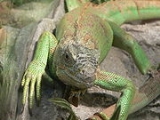
Iguanidae
Encyclopedia
Iguanidae is a family of lizard
s, composed of iguana
s and related species.
Frost et al. redefined this family. The genera belonging to the different subfamilies were assigned to separate families. This view is not generally accepted and the 'traditional' classification is still widely used.
Lizard
Lizards are a widespread group of squamate reptiles, with nearly 3800 species, ranging across all continents except Antarctica as well as most oceanic island chains...
s, composed of iguana
Iguana
Iguana is a herbivorous genus of lizard native to tropical areas of Central America and the Caribbean. The genus was first described in 1768 by Austrian naturalist Josephus Nicolaus Laurenti in his book Specimen Medicum, Exhibens Synopsin Reptilium Emendatam cum Experimentis circa Venena...
s and related species.
Classification of Iguanidae
Two different classification schemes have been used to define the structure of this family. These are the "traditional" classification and the classification presented by Frost et al. (1989).Frost et al. redefined this family. The genera belonging to the different subfamilies were assigned to separate families. This view is not generally accepted and the 'traditional' classification is still widely used.
Traditional classification
Family Iguanidae- Subfamily CorytophaninaeCorytophanidaeCorytophanidae is a family of lizards also called casque head lizards or helmeted lizards. They typically have well-developed head crests in the shape of a casque. This crest is a sexually dimorphic characteristic in males of Basiliscus, but is present in both sexes of Corytophanes and Laemanctus...
: casquehead lizards - Subfamily CrotaphytinaeCrotaphytidaeThe family Crotaphytidae, or collared lizards, are desert-dwelling reptiles native to the southwest USA and northern Mexico. They are very fast-moving animals, with long limbs and tails, and are carnivorous, feeding mainly on insects....
: collared and leopard lizards - Subfamily HoplocercinaeHoplocercidaeFamily Hoplocercidae, or the hoplocercids, are a family of lizards native to the tropical forests of Central and South America. There are ten described species in three genera...
: wood lizards, clubtails - Subfamily Iguaninae: marine, Fijian, Galapagos land, spinytail, rock, desert, green, and chuckwalla iguanas
- Subfamily Leiocephalinae: curly-tailed lizards
- Subfamily LeiosaurinaeLeiosauridaeLeiosauridae is a family of lizards. It contains the following genera:*Genus Diplolaemus*Genus Leiosaurus*Genus Pristidactylus...
- Subfamily LiolaeminaeLiolaemidaeLiolaemidae are a family of iguanian lizards. They are traditionally included in the Iguanidae as subfamily Liolaeminae, which some more recent authors prefer to delimit in a more restricted way...
- Subfamily OplurinaeOpluridaeThe Opluridae, or Madagascan iguanas, are a family of moderately sized lizards native to Madagascar. There are seven species in two genera, with most of the species being in Oplurus. The family includes species that live amongst rocks, some that live in trees, and one that inhabits sand dunes...
: Madagascan iguanids - Subfamily PhrynosomatinaePhrynosomatidaePhrynosomatidae is a diverse family of lizards, found from Panama to the extreme south of Canada. Many members of the group are adapted to life in hot, sandy deserts, although the spiny lizards prefer rocky deserts or even relatively moist forest edges, and the short-horned lizard lives in prairie...
: earless, spiny, tree, side-blotched and horned lizards - Subfamily PolychrotinaePolychrotidaePolychrotidae is a family of lizards commonly known as anoles . NCBI places the anole in subfamily Polychrotinae of the family Iguanidae. Four genera are common: Anolis, Norops, Phenacosaurus, and Polychrus....
: anoles - Subfamily TropidurinaeTropiduridaeThe Tropiduridae is a family of iguanid lizards native to South America and the West Indies. Commonly known as Neotropical ground lizards, most are ground-dwelling animals, and the family includes some lizards adapted to relatively cold climates, including those of the Andes mountains and Tierra...
: neotropical ground lizards
Frost et al. classification of iguanas
Family Iguanidae- Genus Amblyrhynchus – Galápagos marine iguana
- Genus BrachylophusBrachylophusThe genus Brachylophus consists of three extant iguanid species native to the islands of Fiji and a giant extinct species from Tonga in the South Pacific. One of the extant species, B...
– Fijian/Tongan iguanas - Genus ConolophusConolophusThe Galápagos land iguanas comprise the genus Conolophus of the Galápagos Islands. The name Conolophus is derived from two Greek words: conos meaning "spiny" and lophos meaning "crest" or "plume", denoting the spiny crests along the backs of these species...
– Galápagos land iguana - Genus CtenosauraCtenosauraCtenosaura is a genus of lizard commonly known as spinytail iguanas. The genus is part of the large lizard family, Iguanidae and is native to Mexico and Central America. The species range in size from about 5 inches to well over one meter. The distinctive feature of this genus is presence of the...
– spinytail iguanas - Genus CycluraCycluraCyclura is a genus of lizards from the family Iguanidae. Members of this genus are known as "cyclurids" or more commonly as rock iguanas and only occur on islands in the West Indies...
– West Indian rock iguanas - Genus Dipsosaurus – desert iguana
- Genus IguanaIguanaIguana is a herbivorous genus of lizard native to tropical areas of Central America and the Caribbean. The genus was first described in 1768 by Austrian naturalist Josephus Nicolaus Laurenti in his book Specimen Medicum, Exhibens Synopsin Reptilium Emendatam cum Experimentis circa Venena...
– green and lesser Antillean iguanas - Genus Sauromalus – chuckwallas
- Genus Armandisaurus (extinct chuckwalla)
- Genus GangiguanaGangiguanaGangiguana armatus is an extinct genus of primitive iguanid from the Early Cretaceous of India, known primarily from bone fragments...
(extinct) - Genus LapitiguanaLapitiguanaLapitiguana is an extinct genus of giant iguanid from Fiji. It probably went extinct following the human colonization of Fiji 3000 years ago....
(extinct giant Fijian iguana) - Genus PumilaPumilaPumila novaceki is an extinct iguanid that lived in what is now Palm Springs, California, from the Blancan to Irvingtonian stages of the Pliocene to Early Pleistocene.It is currently known from a partially crushed skull...
(extinct Palm Springs iguana)

